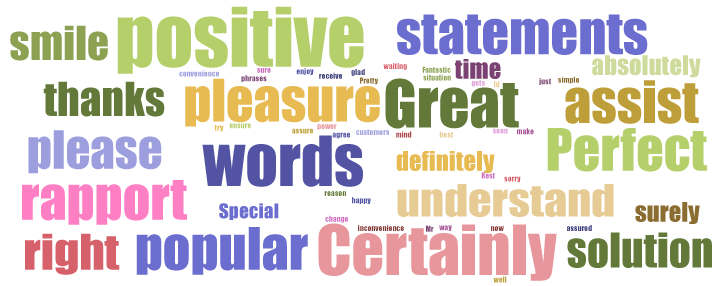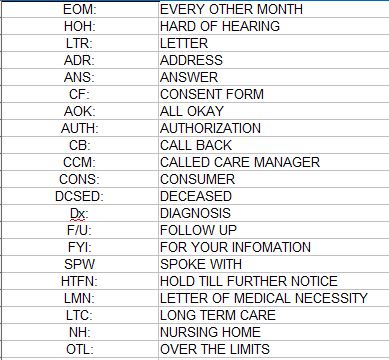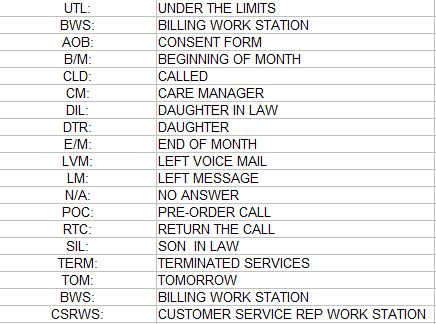THE CALL FLOW (INBOUND CALLS)
I. Opening (greeting and branding)
“Hi thank you for calling Medical Supply Inc, my name is (STATE YOUR NAME). May I ask with whom I am speaking with?”
II. AER (acknowledge, empathize, reassure)
“I know how frustrating it can be, I’ll feel the same way if I am in your situation. Let’s see how I can help you.”
III. Resolve the concern
“Based on what you told me or based on what we have talked about, the Tena Light Pad will suit you the most”- (then give a description of the product). Follow up with a question, “do you agree or would you prefer another product?”
IV. Set proper expectations
“So please expect the free samples to arrive within 3-5 business days then please call us back so we would know the right one for you.”
V. Close the call
“Is there anything I can help you today? Thank you for calling MSI, again my name is __, thank you and have a great day.”
THE CALL FLOW (OUTBOUND CALLS)
Before call:
Look at the dates and look at FO note. Note if the FO note has anything unusual in it.
Dial customer phone. If no answer or the person cant speak, dial the contact number.
Suggested Spiel:
“Hi my name is __ from Medical Supply Inc, May I ask with whom I am speaking with? We just want to let you know that your order for medical supplies will leave our warehouse on (ORDER DATE) and should arrive on or about (DELIVERY DATE). Are your supplies enough to last until the delivery date?”
“Is there a recent change on your address or insurance information?”
“Any concerns or comments about the supplies we are sending?”
Thank you for taking my call, Greg. Have a wonderful week ahead.”
(Only if you sense that the consumer has a time to spare.)
“Along with the shipment that you will receive, you will see a Refer a Friend form, please pass it along so we can send them free samples of our products.”
LEAVING VOICE MESSAGES
IMPORTANT
Do not leave voice messages to OHIO and ILLINOIS.
“Hi my name is _ from Medical Supply Inc. This is to inform that the order for (CUSTOMER NAME) is leaving our warehouse on (ORDER DATE) and will arrive on or about (DELIVERY DATE).
If you need to make any changes to your order or if your address or insurance have recently changed, please call us at 1800 777 6647 and speak with any of our customer service specialists.
Thank you and have a great day!”
IF THE PERSON WHO PICKS UP THE VOICEMAIL NEITHER BEARS CUSTOMER’S NAME OR THE EMERGENCY CONTACT PERSONS NAME:
“If you by any chance are not in any way connected to (CUSTOMER NAME), please give us a call so we can update our records. Our number is 1800 777 6647 and speak with any of our customer service specialists.
Thank you and have a great day!”
POSITIVE WORDS, PHRASES AND EMPATHY STATEMENTS
Positive Words
Definitely
Absolutely
Certainly
Fantastic
Especially
Exactly
Marvelous
Delightful
Reassure
Sample Phrases
“Rest assured Mr..”
“I do understand the inconvenience you have faced..”
“I will be more than glad/ happy to assist you..”
“I will ensure that..”
“What I will do for you right away is..”
“I assure you I will try my best..”
“I’m sorry for the inconvenience that you have faced, what I can do for you is..”

PRACTICE!

Documentation
In American business, when we think of documentation, it often has a negative connotation. So much documentation is the result of bureaucracy or liability protection that it makes most organizations and people averse to it.
But..
AVOID documentation overload!
The reality is that everyone in business today is confronted with information overload, and the most typical response to this problem is to ignore any information that does not represent a flaming emergency.
For customer information, documenting everything is documenting nothing.
The next slide will show why customer documentation is essential to a customer-centric culture:
Information shared is information made useful. You never know what will be relevant. This does not mean you should document every call.
A client’s past experience is often essential to their future experience. How would you treat the consumer differently if you knew that on their last order, they were expecting supplies but the intake of supplies was not forwarded to the warehouse? Or that they have been through three replacement items already.
Knowing a client’s history is great service in and of itself. It is one of the greatest annoyances in all of customer service, when customers have to repeat their story and details repeatedly to different people in the organization. Recording that history so the next team member can use it automatically improves the customer experience.
It helps to know the facts. “Win the Argument, Lose the Customer”, it is important to know the facts of a case. While it does not always mean you will use that information with the customer, it can still be important to know whether you are right or wrong. If a client claims that they never received a phone call from our company and you have documentation showing 4 different calls, it might affect how you approach resolving the issue.
Documenting resolved issues shows who on your team gets it. If given the proper training and tools, creating a culture that believes in proactive documentation will quickly show you who your most customer-centric team members are.
Approved Abbreviations and Acronyms

